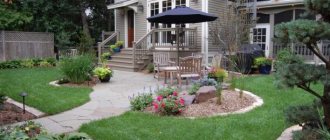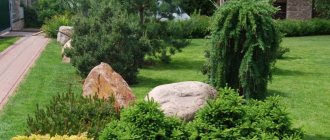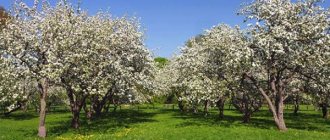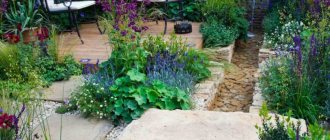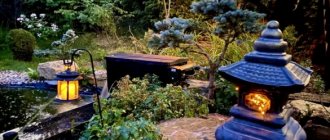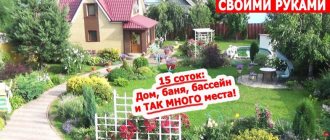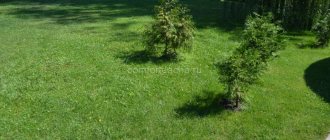Landscape design dates back to ancient times. Of course, then this direction in art did not have such a name. The decoration of the area surrounding the buildings began with temple complexes. The structures erected for the worship of deities were treated with special honor and they tried to appease the members of the pantheon by creating a unique landscape around the holy place. The temples had not only luxurious decoration inside, but picturesque views outside. The sites were decorated with flower beds, flower beds, statues, arches, terraces, decorative ponds and neat paths connecting secondary buildings.
From the history of landscape design
An enormous contribution to the development of landscape architecture was made by the ancient Egyptians, who devoted most of their lives to the worship and praise of deities. In the city of Thebes, for the first time, a tradition arose of decorating not only temple complexes, but also local areas with ponds with fish and underwater flora. The inhabitants of Babylon and Assyria decorated their yards with lush vegetation. Seeds were brought from different parts of the world. One of the Seven Wonders of the World - the Hanging Gardens of Babylon - marked the beginning of this tradition. The Babylonian king, being involved in a bloody war with the Assyrians, entered into an alliance with the Median sovereign. They defeated Assyria in a joint campaign, and to seal the agreement, a marriage was arranged between Nebuchadnezzar and the daughter of the king of Media, Amanis. His wife longed for the green landscapes of her home in the dusty capital of Babylon. Then the king ordered the creation of a magnificent garden on stone supports, equipped with a unique irrigation system. An error crept into history and the building was associated not with the name Amanis, but with Semiramis, the Assyrian queen who lived earlier.
In India, floating gardens were built. The luxurious palaces of Indian nobles were traditionally decorated with spacious ponds, onto which rafts with bulk soil and planted flowers were lowered. In the Middle Ages, unique garden “labyrinths” appeared that decorated summer palaces for the relaxation of crowned persons and their families. History has preserved many magnificent examples of decorating areas around residential buildings. Landscaping in front of the house plays a special role in decorating the area, as it is the “face” of the property, which will be shown to every guest.
Flowerbeds
Flower beds fit harmoniously into the landscape of the garden plot and the local area of the cottage. They are used to decorate recreation areas, garden ponds and, of course, the area at the entrance. There are several options for using plants for the entrance space:
- Decorative hedges made of bushy, lushly flowering plants near a gate or fence. They get along equally well next to a picket fence or metal forging.
- Raised flower beds framing garden paths from the gate to the door itself.
- Spot flower beds near the porch.
What does it consist of and features of the layout
The decor of the area in front of the house will include many elements:
- Green spaces and flower beds.
- Water facilities.
- Gazebos and terraces,
- Fences and gates, gates.
- Track systems.
All these landscape components must be linked into the overall composition. When planning the placement of each element, three aspects are taken into account:
- Relief.
- Climatic features.
- Soil type.
If the home area is spoiled by hills and hollows, there is no need to rush and level the area using bulk soil. Features of the relief can be transformed into advantages that will help create a unique design composition. Zonal division of the territory into small areas involves the placement of separate areas, which are isolated from each other, but at the same time connected by a system of decorative paths. You can set up a gazebo near the house so that in the summer there is somewhere to hide from the scorching sun. A decorative pond will give you coolness along with aesthetic pleasure. Systems of flower beds and flowerbeds will be pleasing to the eye and beneficial if some of them are planted with spices. Green fences do not always serve only a decorative role, because you can decorate your home area with berry bushes.
When planning, the features of the shape of the yard and its size are also taken into account. Two or three acres is enough to accommodate a gazebo, green spaces, a driveway and even a small front garden. To additionally decorate your country courtyard with a lawn or a spacious lawn, you will need a little more space.
Front area
The front area usually carries the main “representative” load and determines the perception of the main object on the site - a residential building. The most commonly used garden elements in this part of the site are parterre lawns and flower beds, free flower arrangements, as well as plantings of coniferous or decorative deciduous trees and shrubs. In the front part, a pond, fountain or other water features are sometimes installed to enliven the area. It is advisable to provide for the placement of garden benches, canopies from the sun and rain, or places for relaxation and conversation with guests.
It is known that open or semi-open spaces look friendlier than closed ones. The shape and dimensions of the front part of the site also matter. A square, rectangle or circle is preferable to an irregular shape or an elongated strip.
When, at the entrance to the site, there is enough space to “spread the eye”, the house, located at some distance, in the depths of the site, focuses attention on itself and is perceived as a whole, and the ground part plays the role of a rich frame for it.
If the house is pushed towards the street, the ground area of the site, which is also the entrance, will, at best, be reduced to the front garden. Thus, the owners often close themselves off from the disturbing world around them and at the same time free up space for their private garden, located behind the house. This is an example of an introverted garden, intended for a narrow circle of people; it can be found in England, and in Holland, and in our country.
The sophistication of the landscape design of the front part of the site must necessarily be combined with the functionality of this territory. No design findings can compensate for basic inconveniences that may relate to the nature of the road surface, the location and size of gates and wickets, the width and turning radius of the entrance road, the magnitude of the slopes, the placement of paths and many others.
When calculating the balance of a site's territory, fairly large areas of paved surfaces are usually provided for the front area. If in general, on a personal plot, hard covering occupies approximately 10–15% of the territory, then in the front part it can be 20–25% or more. Indeed, here, as a rule, there is an entrance road, and often a parking lot and pedestrian paths.
Deciding on the style
The design style of the yard should be tied primarily to the main building - the house. If different directions are selected, then they must have points of contact to create a dynamic mix, an organic combination. The design can be simple or pretentious, luxurious and on a grand scale. More laconic options are suitable for typical dachas, the main purpose of which is summer outdoor recreation and caring for the garden. Chic courtyards, as a rule, decorate townhouses and cottages. A wide range of styles are divided into two groups:
| Historical | These include English, Spanish, French, Russian, Mediterranean, Scandinavian, Mauritanian. |
| Popular modern | This group contains trends that are similar in their characteristics to similar styles in interior design. These include high-tech, eco, modern, minimalism, alpine (chalet). |
Decoration is carried out in accordance with the concept of the direction that was chosen.
Color options
Flowers in the front garden are selected very individually.
Here you can plant perennial plants that do not require much trouble, or annuals that will decorate the flower bed in front of the house in a completely new way every year. The usual ones will look good and traditional:
- velvets;
- nasturtiums;
- carnations;
- daffodils;
- periwinkles;
- hoofweed and other simple inhabitants of the beds.
But if you get a little creative, you can come up with unique selections of flowers and greenery. The following compositions will be interesting combinations:
- elegant begonias with red and pink buds, gracefully shaded by silvery branches of cineraria;
- noble roses and fairly simple lupins and foxgloves;
- fluffy peonies and delicate daylilies, bright phlox, exquisite irises;
- charming hydrangeas that perfectly cover all the shortcomings of the house;
- exquisite delphiniums, lilies, lupins, arranged in a white wave;
- hosta and ferns.
You can create a completely unusual front garden with your own hands if you replace the usual flowers with ordinary vegetables, beautifully arranged around the central element.
A front garden in the form of a prairie, created from grasses, will look original, but such a solution will require quite complex care.
It all starts with a wicket, gate and fence
The outer fence should be high and monumental. Its main function is to protect the site from unauthorized entry by uninvited guests. The beauty of the fence fades into the background. Based on the material used, fences are classified into the following types:
- Stone. Durable material used for permanent fencing. The stone is universal and fits almost any style. If only the foundation part and dividing columns between sections are made from it, then the material can be combined with brick, metal or wood.
- Wood. It looks organic in combination with Provence, country and Russian style. In order for a wooden fence to last a long time, the material must be protected with a special impregnation that prevents moisture from entering the micropores of the wood.
- Metal. Forged elements can create an elegant, sophisticated composition, but at the same time they do an excellent job with the protective function of the fence.
- Brick. This type of fencing will last a long time, but has a slightly rustic appearance. Suitable for modern styles.
- Concrete. The material is poured into special molds, and the result is identical sections for fencing. Concrete has an affordable price, but at the same time allows you to choose an original design.
- Slate. An unsightly fence made of this material is suitable as a temporary option. The wicket and gate are matched to the fence, since these elements are part of one composition.
Planning
Before deciding the question “How to make a beautiful front garden”, you need to decide:
- with the size of the area allocated for it (a small front garden will be lost in a large area or will not accommodate all the planned plants);
- possible time spent on his care;
- material costs for the purchase of seeds or seedlings;
- seasonality of flowering (it is preferable to choose plants that can bloom all season, and for residents of a year-round home to purchase evergreen plantings);
- sun exposure of the area.
By the way, even a small, inexpensive flower garden with the most ordinary plants can look very attractive if you put some of your soul into it.
Arrangement of paths and entrances
The yard is decorated with a main entrance road leading to the house and decorative branches along which people can walk. For the land plot, choose a durable concrete, stone, brick or asphalt covering. The options look original when gaps filled with grass are left between smooth cobblestones.
Decorative paths are made from less reliable materials that decorate the landscape. These include:
- Gravel, crushed stone, pebbles. To prevent small pebbles from being carried throughout the area, the path is fenced with green spaces or flower beds.
- Sand. A budget option that turns into mush when it rains.
- Tree. Decks look presentable and blend with rustic style, but will not last long.
- Ceramic tile. From pieces of tile laid out using the mosaic technique, you can create a colorful and creative path.
- Plastic. Special modules are sold in stores, but this option looks cheap and unpresentable.
- Wood cuts. The walkway will last a long time, but its installation will be accompanied by large-scale excavation work, because the decks are of a decent height. This is necessary so that the track can withstand heavy loads. Flat “pancakes” of saw cuts will quickly crack.
- Traffic jams. An original option that will require painstaking work from the designer. Decorative paths can also be made of concrete or brick, but combining materials will create a complex landscape picture.
Interior
There are no restrictions here. You can decorate the area adjacent to the house with a charming front garden, flower borders, and the same vines that hide some of the shortcomings of the buildings.
You can build arches and pergolas and weave them with ornamental plants that transport the owners and their guests somewhere closer to the sea.
In the same way, you can decorate other country houses: wooden gazebos, patios, sheds, bathhouses.
Small flower beds and borders will limit the territory of the internal parking lot, pond, and divide the area into functional zones.
Lighting
Patio lighting at a summer cottage is divided into two types:
- Functional or basic.
- Decorative.
The first is necessary for comfortable movement around the yard at night, and the second simply emphasizes the advantages of the decor. For street lighting, it is not recommended to use fluorescent lamps, which will not work at low temperatures. The wiring is laid underground to eliminate the risk of mechanical damage. The best option when choosing light bulbs are halogen and LED devices. They have a long service life and low energy consumption.
If the owners are not night owls and do not spend nights outside, then solar-powered lamps can be used. In terms of economy, they are the leaders among lighting devices. The light bulbs only work for 4-5 hours at night, since the energy accumulated during the day is not enough for more.
DIY garden decor
To give the summer cottage a cozy atmosphere, it is landscaped with flower beds, bridges, lighting fixtures and lamp posts.
An old thing and a little imagination - and you will create an original craft.
The illumination of decorative trees and a cascade of flowers at night will pleasantly surprise you with its exquisite and sophisticated beauty.
In the garden of the dacha it would be nice to make a small pond lined with stones around the perimeter. It is worth making a decorative bridge across it, on the handrails of which lamps will be placed. Also, the lighting is installed directly on the bottom of the reservoir. This will create a glow throughout the mirror surface at night.
A small pond from an old bathtub looks great if you decorate it effectively with pebbles
Wooden ducks to decorate your pond
If the area of the land allows, the reservoir is constructed in a relatively large size. Such expanse of water makes it possible to construct a Venetian gondola, the mast of which will be crowned with an oil lantern.
If you have the makings of a sculptor, then make a gondolier from polyurethane foam. If you don’t have any, buy a dummy and dress it in the clothes typical of a boat driver. Rest assured, such an exclusive will not be found within a radius of 1000 kilometers from you.
Garden flower beds should be diluted with green shrubs. When choosing colors, you need to be guided by the gamut compatibility table. In order to evenly distribute the fullness of the architecture, the dacha area should be filled with flower beds and lawn grass. The latter creates the effect of spaciousness, when, on the contrary, the flower beds attract attention and greatly burden the observer.
A successful combination of colors of shrubs planted near the porch of a country house
Make several large flower beds around the entire perimeter of the site. The composition of plants should be selected, paying attention to the combination of different types of plantings.
A relief flowerbed will look interesting. Its installation is possible in any landscape of the dacha. To do this, at the planning stage, you need to determine the location of such flower beds, and before planting the lawn, first carry out earthworks to create a hillock. Rocky areas are arranged between the plantings, in which, if desired, small fountains can be made.
Even simple brick flower beds look interesting
Landscaping takes many years to complete. This is a voluminous and labor-intensive job. But, with due diligence, your summer cottage will be transformed from a standard and familiar Russian vegetable garden into a cozy and pleasant place, where you will feel the tranquility and alluring beauty of nature. Create with us!
Expert opinion
Alina Kvileva
Landscape designer
Hello, my name is Alina and I am a landscape designer, if you have any questions regarding landscape design, ask, I will be happy to answer them.
See alsoModern landscape design. Main trends
Gardening methods
Green spaces are divided into three types:
- Trees. Due to their decent height, they cannot be planted close to the fence, as the shadow may disturb the neighbors.
- Shrubs. They create original compositions, animals and geometric shapes.
- Flowers and other low plants.
Trees are used to create slender rows along paths or small front gardens with fruit varieties. Flowers are collected in colorful arrangements for flower beds. Different types of plantings can be combined with each other.
Selection of plants and planting principle
Plants must be selected taking into account the following criteria:
- Soil features.
- Groundwater level and location of the site (lowland or upland).
- Climatic conditions.
Moisture accumulates in lowlands after heavy rains. For this reason, such areas become swamped and become unsuitable for most plants. It is much easier with higher elevations, since it is easier to water one more time than to artificially drain the soil. The viability of certain plant species also depends on the composition of the soil. Poor rocky soil will be a test for delicate flowers. Sand in dry areas does not retain moisture, so a quality irrigation system will be required. Chernozem is considered the most nutritious, but with heavy rains it turns into a dirty “porridge”. The solution for poor soil will be a bulk layer, which is brought specially for plantings. For plants, 0.5 m of soil will be enough, but for shrubs and trees that have a powerful, developed root system, you will have to order several trucks.
It is also necessary to take into account the compatibility of certain plants with each other. Some “selfish” people can suck all the juices out of the earth and provoke their neighbors to slowly wither. Such aggressive specimens are planted at a distance.
Creation of flower beds and flowerbeds
A flower garden is a broad concept that combines variations in planting. It is classified into types:
- Free. The flower garden does not have any fences, and the riot of flora is tamed by systematic processing.
- Mixborders. A ribbon flower garden is limited on one side by a fence and is often planted along paths. The name of the decorative element was obtained as a result of the merger of two words: mix (mixing) and border.
- Flowerbeds. This type of flower garden has a fence. It is given a variety of shapes: from rectangular to round.
- Border of flowers. Typically, it is planted from low flower bushes that border the lawn from the driveway or garden path. Flower beds can also be modular, mixed and multi-dimensional. If you choose the right types of plants, you can get an original gradation of color in the flowerbed.
Shaped design of bushes
Trimming plants is not as simple as it might seem at first glance. Only certain types of shrubs are suitable for figured plantings: boxwood, cotoneaster, privet, yew and holly. They are easy to cut. Boxwood is poisonous, so pets and children should be kept away from it. Privet is ideal for “lazy” gardeners, as it only requires trimming once a year. Until the desired result is obtained, the plant is limited to a homemade wire frame. If you don’t get the hang of this, then they buy special templates, inside which the bushes develop in the right direction and are adjusted to the shape. Geometric shapes are considered the simplest, but animals or people will take years to create.
Trees - how to choose and which ones are best to plant
In landscape design, trees are classified into four types:
- Conifers. They are good because they retain their green colors even in winter. Conifers prefer shade and are hardy.
- Deciduous. A favorite option among designers. They are divided into two subspecies: decorative deciduous and flowering.
- Fruit. These include apple trees, pears, cherries, apricots, cherries, and plums.
- Evergreen deciduous. In winter, they do not expose their crowns, but require special care. Trees are planted according to four principles:
- Groups. They usually combine fruit trees.
- Solitaires. A single thuja or pine tree on the site will definitely attract attention.
- Alleys. Trees are planted on both sides of the path.
- Hedge. Although it is usually made from shrubs, a “decoration” made from trees will more reliably protect the area from prying eyes from the street.
Do not forget that neighboring trees are also selected based on the principle of compatibility, like flowers.
Subtleties in front garden design and choice of style
The choice of plants mainly depends on the style of the landscape. Conifers are used for a regular or Japanese garden. Cereals are suitable for country or landscape style.
Which style to choose for front garden design, let’s look at the most common ones:
- Country or rustic - characterized by flowering lawns and the use of a wooden fence. The style is characterized by some negligence. Suitable for flowerbeds: daisies, marigolds, nasturtiums, flax, field cornflowers. Shrubs that are suitable for a rustic landscape: lilac, jasmine, rose hips, viburnum.
- The regular style is distinguished by clear shapes, straight lines, and tree crowns are clearly formed. The entrance area in a regular style will look as formal as possible. They use junipers, thujas, barberries, boxwoods and other plants that tolerate shaping haircuts well. Also, a front garden in a regular style can be decorated with small architectural forms, for example, a fountain or statues.
- Landscape (or naturgarden) reflects natural landscapes and looks as natural as possible. Stone and wood are used for decoration. Plants are selected that are least whimsical and characteristic of the area. This design can be considered a low-maintenance garden.
- The Mediterranean style is characterized by an abundance of stone in its different forms: pebbles, gravel, boulders. Quite difficult to implement, since exotic plants are used. They do not take root well in the climate of the middle zone. Therefore, plants that are more adapted are often used: silver oleaster instead of olive, columnar thujas instead of cypresses, barberry to form topiary, boxwood is suitable for hedges.
- The Japanese garden is decorated with compositions of conifers and stones of various sizes. Junipers, dwarf pines, and maples are suitable. To create a unique color, plants must be trimmed regularly.
- Minimalism - the style speaks for itself: a minimum of plantings and decor. Strict lines and open space, free territory is usually sown with lawn.
Water features
The set of water features in landscape design includes:
- Sources. This is the beginning of the bed of an artificial reservoir or natural stream.
- Fountains. Artificial structures in which jets of water are thrown out under pressure.
- Streams. They have a curved, irregular shape and a narrow channel.
- Waterfalls. They are a stream whose water flows over obstacles (most often stones).
- Cascades. A system of several waterfalls.
- Ponds with standing water.
It is not necessary to artificially erect complex structures if a natural water “artery” flows through the site; its banks are decorated with stones and complicated with barriers to form cascades. Swimming pools also belong to this type of decor, but they rarely decorate courtyards on sites, since such an arrangement is considered impractical.
Filling the summer cottage
The landscaping project must include not only trees and shrubs, but also greenhouses and hotbeds where more capricious vegetable crops and exotic flowers will bask. If, of course, this is included in the plans of the site owners.
Although no one knows how life will turn out and, perhaps, very soon the owners of the land plot will want to plant their own tomatoes and cucumbers. And the sunny place is already occupied by a spreading apple tree or juniper bush.
Original terraces and gazebos
A separate seating area will be a functional addition to the patio. For these purposes, gazebos and terraces are built. The first ones are divided into several types according to the type of construction:
- Open. These lightweight gazebos consist of supports and a roof. Used for recreation in the summer.
- Half open. As a rule, they have decorative walls made of forged elements or wooden slats.
- Closed. The design of the gazebo includes glazing and walls. Used for winter recreation. Monumental structures are even equipped with a stove.
Separately, it is worth noting the pergolas. These structures are similar to gazebos, but instead of a roof they have a “canopy” of climbing plants (grapes, ivy) that wrap around the frame. The shapes of the structures can be round, square and polygonal. The terrace is an artificially created hill on which tables, chairs, and sofas are placed. They are classified into three types:
- Closed. The building consists of walls and a roof. It can stand separately from the house or adjacent to it. Rain and wind are not a problem for vacationers on such terraces.
- Half open. They have a roof and light curtains are used instead of walls.
- Glazed. Their design includes a roof and panoramic windows. The main advantage of the terrace is the abundance of sunlight and protection from bad weather. Another special type of structure consists of only walls, but the structure is placed in backyards. This design element is typical for the Spanish style.
Green rooms
Recently, it has become fashionable to organize rooms that are located in the fresh air. As a rule, such green rooms are installed in the front garden, in the gazebo, on the terrace or in the garden. Green rooms are equipped with light furniture, a table for tea drinking, lamps that create a cozy atmosphere in the evening, and container plants.



